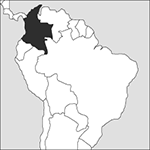
Source: MAPS IN MINUTES™ © RH Publications (1997)
Capital:
Bogotá
Area:
1,138,910 sq km (439,736 sq miles)
Population:
45,745,783 (2012 est)
Currency:
1 peso = 100 centavos
Religions:
Roman Catholic 90.0%
Ethnic Groups:
Mestizo 58.0%; White 20.0%; Mulatto 14.0%; Black 4.0%
Languages:
Spanish (official); Amerindian languages
International Organizations:
UN; OAS; Andean Community; Non-Aligned Movement; WTO
A country in the extreme north-west of the South American continent, the only South American country with coasts on both the Pacific and the Atlantic oceans, separated by the isthmus of Panama. To the east is Venezuela, and to the south Brazil, Peru, and Ecuador.
Physical
The northern end of the Andes occupies the north-western half of the country, breaking into three great cordilleras which enclose high, cool plateaux. Running from them are several large rivers to water the hot northern coastal plains. South-east of the Andes, plains of rich pasture stretch away to the east and to the south, where the land falls in forested terraces towards the headstreams of the Amazon.
Economy
Oil exports are crucial to Colombia’s economy, but other industries are being developed, including textiles, clothing, and food processing. As well as crude oil, Colombia has large reserves of coal, natural gas, gold, precious stones, platinum, bauxite, and copper. About 5% of Colombia’s total area is arable, while 30% is permanent pastureland; coffee, flowers, and bananas are the most important crops. However, cannabis and coca are also cultivated illicitly on a vast scale for the manufacture of illegal drugs.
History
Colombia was occupied by the Chibcha Indians before the Spanish conquest. The first permanent European settlements were made on the Caribbean coast, Santa Marta being founded in 1525 and Cartagena eight years later. Colonization of the interior was led by Gonzalo Jiménez de Quesada, who defeated the Chibchas and founded the city of Bogotá in 1538. The region was initially part of the viceroyalty of Peru, but a different political status came with the establishment of the viceroyalty of New Granada in the first half of the 18th century. The viceroy sitting in Bogotá was given jurisdiction over Colombia, but also over Venezuela, Ecuador, and Panama. Colombia remained a viceroyalty of Spain until the battle of Boyacá (1819) during the Spanish–South American Wars of Independence, when, joined with Venezuela, it was named by Simón Bolívar the United States of Colombia. In 1822 under his leadership New Granada, Panama, Venezuela, and Ecuador were united as the Republic of Gran Colombia, which collapsed in 1830. In 1832 a constitution for New Granada was promulgated by Francisco Santander, which was amended in 1858 to allow a confederation of nine states within the central republic, which is now known as the Granadine Confederation. In 1863 the country was renamed the United States of Colombia. The constitution of 1886 abolished the sovereignty of the states and the presidential system of the newly named Republic of Colombia was established. The War of the Thousand Days (1899–1902), encouraged by the USA, led to the separation of Panama from Colombia (1903). Violence broke out again in 1948 and moved from urban to rural areas, precipitating a military government between 1953 and 1958. A semi-representative democracy was restored that achieved a degree of political stability. During the 1980s Colombia achieved sustained economic growth and a successful record of external debt management, but the drug trade increasingly dominated both internal affairs and its relations with the USA. At the same time numerous extremist guerrilla groups, of both Left and Right, resorted to violence. In 1990 the ruling Liberal Party convened a Constitutional Assembly, which produced a new constitution, followed by an agreement by some guerrillas to demobilize and take part in the political process, while several drug traffickers surrendered. However, violence by such left-wing groups as the FARC (Revolutionary Armed Forces of Colombia) and ELN (National Liberation Army), financed largely by the production of and trade in drugs, continued to be a major disruptive force in the 21st century. Peace talks began in 2012, during the presidency of Juan Manuel Santos. He was awarded the 2016 Nobel Peace Prize for his efforts to end the conflict. Agreement between the government and FARC was reached in 2016, but the resulting deal was rejected in a referendum, throwing the peace process into turmoil.
- mofette
- moffette
- Mogensen, Andreas (1976– )
- Mogi doughnut hypothesis
- mogote
- Moguls
- Mohawk
- Mohawkian
- Mohenjo-Daro
- Mohicans
- MOHLL
- Mohnian
- Moho
- Moho discontinuity
- Mohorovicˇić discontinuity
- Mohorovičić, Andrija
- Mohorovičić, Andrija (1857–1936)
- Mohri, Mamoru (1948– )
- Mohr stress diagram
- Mohs, Friedrich
- Mohs, Friedrich (1773–1839)
- Mohs scale
- Mohs’ scale
- Mohs’s scale of hardness
- Moh’s scale